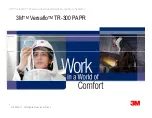
Page 4 of 32
P/N 89332-01 Rev F 7/11
FACEPIECE FITTING AND FIT TESTING
A respirator Quantitative Fit Test must be performed to ensure the correct
respirator facepiece size has been selected and assigned to the user. It is
the responsibility of the Respiratory Protection Program Manager or Safety
Coordinator to assist the user in selecting the correct respirator size relative
to the user’s facial features and dimensions. Fit Testing must be performed
with any approved SCOTT accessories that will be used with the respirator
installed, such as a communications device installed on the facepiece.
Respirator fit tests are explained fully in the American National Standard
Practices for Respiratory Protection, ANSI Z88.10-2001 which is published
by the American National Standards Institute (ANSI), 11 West 42nd Street,
New York, New York, 10036, and in the Occupational Safety and Health
Standards, OSHA 29 CFR 1910.134 Appendix A, which is published by the
Occupational Safety and Health Administration (OSHA), 200 Constitution
Avenue, NW, Washington DC, 20210.
Quantitative Fit Testing per OSHA Standard 29 CFR Part 1910.134 Appendix A,
or ANSI Standard Z88.10-2001 requires testing in the negative pressure mode
using equipment such as a Portacount
1
Respirator Fit Tester. For Quantitative
Fit Testing, SCOTT facepieces require use of the appropriate negative pres-
sure testing equipment such as the Portacount Respirator Fit Tester along
with the following:
• SCOTT 40mm facepiece Adapter, P/N 200423-01,
• a new SCOTT P100 Cartridge, P/N 052683,
• SCOTT Probed Fit Test Adapter P/N 805628-01 or equivalent probed
facepieces and the full range of sizes and styles
• Mask Seal Kit, P/N 805655-01
• the appropriate SCOTT communication device and mounting bracket
properly installed on the facepiece, if such an accessory will be used
with the respirator.
• any other optional hood, eyeglass, or other accessory that will be used
with the respirator.
The size and style facepiece must be selected based on the user’s measured
face size. For initial fitting, carefully don the facepiece and conduct a NEGA-
TIVE PRESSURE LEAK TEST according to the instructions provided with the
40mm Adapter. Refer to the DONNING PROCEDURE section of this instruc-
tion for the procedure. Follow the DONNING PROCEDURE
CAREFULLY
. If
the selected facepiece does not pass the NEGATIVE PRESSURE LEAK TEST
or does not fit securely without movement in the chin or chin cup area or the
user experiences discomfort in the chin or throat, try the next nearest size,
larger or smaller. After passing the NEGATIVE PRESSURE LEAK TEST, the
facepiece size selected must be verified by successfully passing a respirator
Quantitative Fit Test.
When fit testing for Open-Circuit, Pressure Demand Self-Contained Breathing
Apparatus and/or Type C Pressure-Demand Supplied Air Respirator mode
of operation (minimum Fit Factor equal to or greater than 500 minimum)
appropriate negative pressure testing equipment must be used. You should
use a P100 Filter, SCOTT P/N 052683 and the SCOTT P/N 805628-01 Fit
Test Adapter.
When using a Portacount Respirator Fit Tester for Quantitative Fit Testing, TSI
recommends that the level of particles in the ambient air must be between
5000 and 30000 particles/cm3. Refer to the Portacount Respirator Fit Tester
user instructions for details including available Particle Generators to use
with the Portacount Respirator Fit Tester if you have difficulty achieving the
minimum level of ambient particle count required.
Test subjects must be in good health at the time of the fit testing. Smoking
or eating less than 30 minutes prior to the test is prohibited. Any and all
conditions that might interfere with a good face to facepiece seal must be
addressed and corrected before performing the fit testing. Refer to the list of
conditions in the DONNING PROCEDURES section of this instruction.
WARNING
FIT TESTING IN ACCORDANCE WITH OSHA
STANDARD 29 CFR PART 1910 IS REQUIRED
AS PART OF THE REQUIRED TRAINING
BEFORE USE OF THIS RESPIRATOR.
FAILURE TO PROPERLY FIT AND TRAIN
THE USER IN USE OF THE FACEPIECE AND
RESPIRATOR MAY RESULT IN EXPOSURE
TO THE HAZARDOUS ATMOSPHERE WHICH
COULD LEAD TO SERIOUS INJURY OR
DEATH.
WARNING
THE USER MUST BE PROPERLY FITTED
USING A RESPIRATOR QUANTITATIVE FIT
TEST BEFORE USE AND FOLLOW ALL
WARNINGS AND SPECIAL OR CRITICAL
USER’S INSTRUCTIONS SPECIFIED DURING
USE. FAILURE TO DO SO MAY RESULT IN
SERIOUS INJURY OR DEATH.
WARNING
RESPIRATORS SHALL NOT BE WORN WHEN
CONDITIONS PREVENT A GOOD FACE
SEAL. SUCH CONDITIONS MAY INCLUDE,
BUT ARE NOT LIMITED TO, GROWTH OF
BEARDS, SIDEBURNS, FACIAL HAIR OR LOW
HAIRLINE THAT CROSSES OR INTERFERES
WITH THE SEALING SURFACE, THICK OR
PROTRUDING HAIRSTYLES SUCH AS PONY
TAILS OR BUNS THAT INTERFERE WITH
THE SMOOTH AND CLOSE FIT OF THE HEAD
HARNESS TO THE HEAD, A SKULL CAP
THAT PROJECTS UNDER THE FACEPIECE,
TEMPLE PIECES ON CORRECTIVE EYE
GLASSES, EXCESSIVE USE OF COSMETICS
INCLUDING MOISTURIZERS, MAKE-UP,
OR AFTER SHAVE, OR ANYTHING ELSE
WHICH INTERFERES WITH THE FACE TO
FACEPIECE SEAL. ALSO, THE ABSENCE OF
ONE OR BOTH DENTURES CAN SERIOUSLY
AFFECT THE FIT OF A FACEPIECE. USE OF
AN IMPROPERLY FITTED FACEPIECE MAY
LEAD TO EXPOSURE TO THE HAZARDOUS
ATMOSPHERE WHICH COULD RESULT IN
SERIOUS INJURY OR DEATH.





































